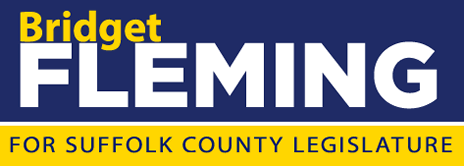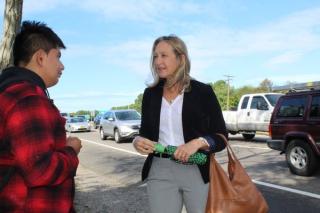As she waited for the S92 bus to pull onto the narrow shoulder that passes for a bus stop inches away from the roaring traffic of County Road 39 in Southampton on Friday morning, Suffolk County Legislator Bridget Fleming looked for waiting passengers to talk with about their daily commute.Her gaze fell upon Bryan Atancuri, a 17-year-old senior at Southampton High School, as he was shuffling his feet in the dirt and playing with his iPhone. Living north of County Road 39 in Shinnecock Hills, Bryan must cross four lanes of traffic every time he needs to take the Suffolk County transit bus to his job at the Carvel on Montauk Highway in Bridgehampton, a roughly half-hour trip most days, depending on traffic.
He also explained to Ms. Fleming, who took the bus on Friday as part of her Car Free Day mission and wants to help remedy the South Fork’s public transportation shortcomings, that the county’s inefficient and unreliable bus system makes his life difficult. He noted that he typically arrives 30 minutes ahead of schedule due to the bus’s sporadically early departures, and all that lost time and uncertainty make it difficult for him to balance his school workload—Bryan volunteers with the high school stage crew, yearbook club and oversees his own pet project, the Latino Culture Club—with the demands of his part-time job.
But Bryan’s primary concern is not for himself, but for his aging mother. The necessary trot from their home to the bus stop, which requires crossing four lanes of heavy traffic, is a significant challenge for his mother, who is crippled with bad knees.
“I always feel bad because she always has to wait for the bus, and wait for the traffic to clear before she can even cross the street,” he said. “Her knees are just giving out, and I don’t want anything bad to happen to her.”
Grace Chris, another local and frequent bus rider, walked up to the stop after having to climb through the brush at the side of the road to avoid the thunderous streams of traffic on the intimidatingly tight shoulder.
“I take my life in my hands,” she said. “If I take this bus to Southampton, on the way back, it drops me off across the street. Then I have to cross all of the traffic to get back. It’s scary. It’s a matter of life and death.”
Ms. Chris said she tried submitting ideas, like the installation of a yield sign or the construction of a pedestrian overpass when County Road 39 was being widened, but to no avail. “Safety is clearly not a priority,” she added, referring to Suffolk officials.
Earlier this year, county officials announced that they have set aside $350,000 to study the feasibility of installing sidewalks along a two-and-a-half-mile stretch of County Road 39, with a portion of that money earmarked to study the cost of widening the shoulder and installing a shelter for those who wait at the bus stop where the road converges with Sunrise Highway.
But none of that funding will go toward improving the actual service, a notoriously underutilized bus system that, last fall, endured massive cuts—including the elimination of three East End routes—due to low ridership. Still, critics argue that ridership is down because the buses are not a reliable form of public transportation, meaning that locals will use them only when they have no other options.
On Friday morning, the bus pulled up just a few minutes late, and Ms. Fleming boarded, buoyed by these conversations and ready to dive into more of her constituency’s transportation problems. Her pool of constituents was small.
The dozen passengers on the bus, including Bryan and Ms. Chris, all disembarked after a few stops, leaving the bus mostly empty. Ms. Fleming was not surprised.
“If the bus system was better and more reliable, more people would get out of their cars and use it,” she said. “But unfortunately, what you hear is that people only take the bus because they have to—they’d much rather have a car. And I really think that’s moving in the wrong direction for a community that really only has one east-west artery.”
She also cited the environmental concerns of a coastal town, and that the emissions from such a high volume of cars would only increase the nitrogen levels in the surrounding water. While she wanted to speak directly with passengers, Ms. Fleming picked Friday to take a ride on the bus because Suffolk County had designated it Car Free Day in an attempt to bring attention to the pollution created by single-occupancy vehicles and encourage people to rely on sustainable methods of public transportation.
Ms. Fleming said she wants to reinvigorate the county’s bus system, fixing nonsensical routes and putting together an operation that serves the people who were left behind after routes were abandoned last year. In early October 2016, Suffolk County cut eight of its least-utilized bus routes, including three on the South Fork, saving an estimated $4 million annually and helping trim a then-$78 million budget deficit. These three routes—the 10D/10E, the 10A and the S90—collectively serviced East Quogue, Hampton Bays, Sag Harbor, North Haven and Westhampton Beach.
In the void left by these cuts, Ms. Fleming wants to recalibrate the remaining routes, investigating how to make them more efficient for the first time in 30 years. She’ll be examining this issue alongside the other members of the Transportation Working Group, a coalition of 11 county officials that also includes a member of the Long Island Bus Riders Union and other transit representatives.
She admits, though, that funding remains the primary issue. She hopes to get some through a bigger return of Metropolitan Transportation Authority, or MTA, payroll tax dollars, a bigger share of State Transportation Operating Assistance funding and a change in policy with ride-share companies like Uber to get a fraction of that surcharge. Though there are similar bills in both the State Senate and Assembly presently, measures that would allow suburban counties to retain a portion of the MTA payroll tax to help defray the cost of operating and maintaining mass transportation, the Senate version has been stalled in Albany.
As to Ms. Fleming’s second goal, she notes that the state currently distributes about $3 billion annually to help counties pay for mass transportation—while pointing out that Suffolk is slated to receive only $26,443,700 in the 2017-18 state budget. She said she hopes to increase that figure, noting that the county’s Budget Review Office has determined that there is no formula dictating how those state transportation funds are dispersed.
The proposed taxing on shared rider services, meanwhile, has stalled and, presently, there are no immediate plans to divert some of those surcharge fees to help fund public transportation.
While she has many ideas on how to fix the situation, the former Southampton Town Board member acknowledges that most of the power lies in Albany, and with changing the way the State Transportation Operating Assistance funds are handed out.
“We’ll keep lobbying to get this done,” she said looking around the empty bus on Friday. “But a lot depends on our state representatives.”

